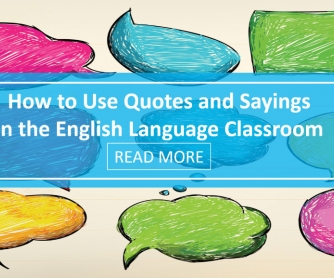
"Don't cry because it's over, smile because it happened."
"It is during our darkest moments that we must focus to see the light."
"'Tis better to have loved and lost than never to have loved at all."
The quotes about represent some of the best-known quotes and sayings in the English language. Chances are your (and possible your students) social media feed is full of quotes on a daily basis. If you follow BusyTeacher on Facebook or Twitter, you know that we post an #edquote almost every day. Quotes and sayings are used to inspire, to teach, to encourage, and to inform. They can also be used to help students in the English language classroom.
Quotes to Spark Discussion
Choose a quote that is controversial and use it to get students talking in the classroom. You could pull a quote from a current news story or take something uttered by a much-despised politician. The quote could be about a hot-button issue, such as abortion or the death penalty, or it could be something lighter, such as an opinion on which football team is the greatest. To get started, try out some quotes from Donald Trump.
Quotes to Improve Comprehension
In addition to using quotes to spark discussion, you can use quotes to improve comprehension skills. Rather than giving students a long piece of text, give them a shorter quote and ask them to tell you what it means. For example, give students the quote "Nothing is impossible. The word itself says, "I'm possible" and have them explain what it means. Another fun activity to improve comprehension and speaking skills is to give students a selection of quotes, ask a question, and have them choose which quote to use to respond to the question.
Quotes to Categorize
You can further improve comprehension by giving students a selection of quotes and having them categorize them based on common themes. For example, students may groiup some quotes in the "love" category and some quotes in the "friendship" category. This helps students think more deeply about the quotes they're reading and begin to make connections between texts. It's also a good accompaniment to a lesson in theme.
Quotes to Distinguish Between Literal and Figurative Language
Quotes can also introduce students to figurative language. For example, you could share with students the quote "Try to be a rainbow in someone's cloud" and have them explain how they can be a rainbow in someone's cloud or draw pictures to compare the literal and figurative meaning of the text. Some may draw pictures of clouds with rainbows in the middle, and then draw pictures of a person smiling or doing a kind thing for someone else.
Quotes to Teach Grammar
If you're looking for new sentences to help teach concepts such as the use of adjectives, sentence structure, or particular verb tenses, look for quotes. They're often short sentences that can help illustrate key concepts. Share the quotes with students and have them guess the tense or highlight adjectives. For sentence structure, give students a quote and have them write their own quote that mimics the style. For example, "Don't cry because it's over, smle because it happened" could become "Don't cry because you got cheese pizza, smile because you have food to eat."
Quotes to Teach Vocabulary
Quotes are also a great place to find frequently confused words or common vocabulary words you wish to teach. Goodreads allows you to search for quotes by keyword, right down to wrods like there and their. Pull out a selection of quotes that use a particular word to show students how the word is used. It's also a great way to show students that words can have different meanings.
Quotes to Teach Source Reliability
Have you ever seen a quote credited to one person when you know it came from someone else? Give students a selection of quotes and have them try to figure out who said them. As students look at different sites, point out the fact that some sites are not as reliable as others and encourage them to find multiple sources to support their answers.
Quotes to Motivate and Encourage
Of course, you can also just pull out popular quotes to motivate and inspire your students. Print out quotes and place them around the room. Add inspiring quotes to the bottoms of tests and quizzes to give students a boost of energy. Write quotes on index cards and pass them out to students when they need them. Add quotes to your PowerPoint presentations. Sometimes students just need to hear something positive and there are plenty of quotes out there to help.
If you're ready to teach quotes in the classroom, here are a few sites to get you started:
Brainy Quote offers a large selection of popular quotes searchable by keyword and author.
Wikiquote features a quote of the day and a searchable database.
Litquotes has over 2,000 quotes from literature searchable by title and author.
Quotationize links quotes to their original sources so you can be sure they're credible.
Quotacle allows users to search thousands of lines from movies.
P.S. If you enjoyed this article, please help spread it by clicking one of those sharing buttons below. And if you are interested in more, you should follow our Facebook page where we share more about creative, non-boring ways to teach English.








